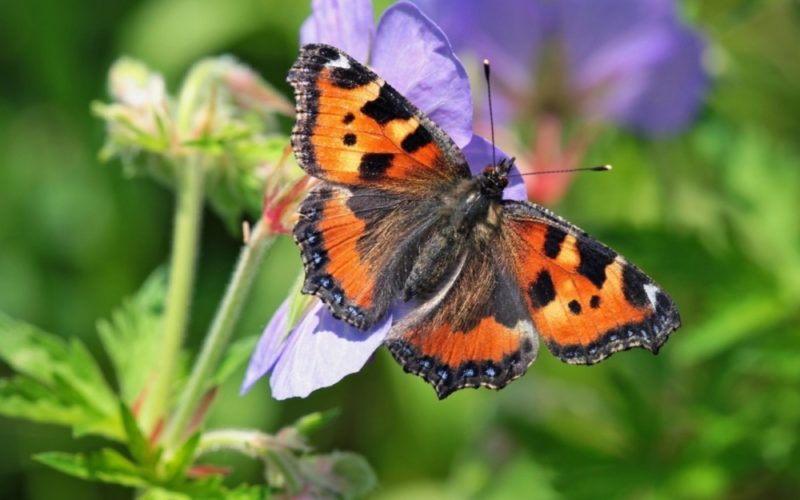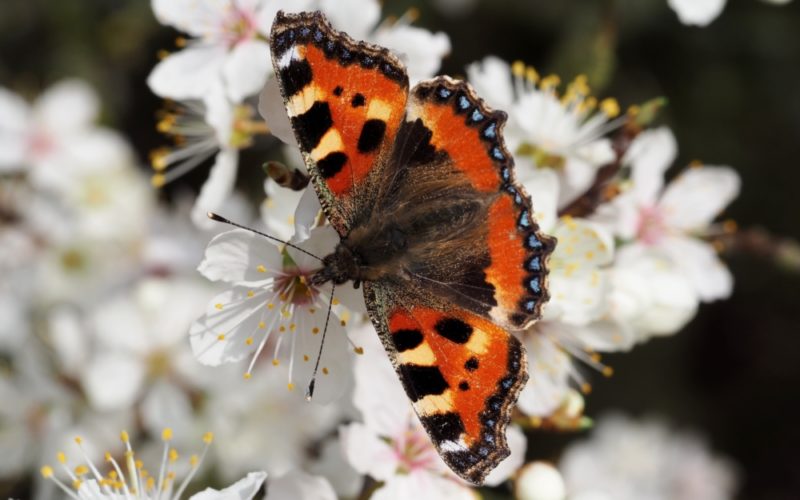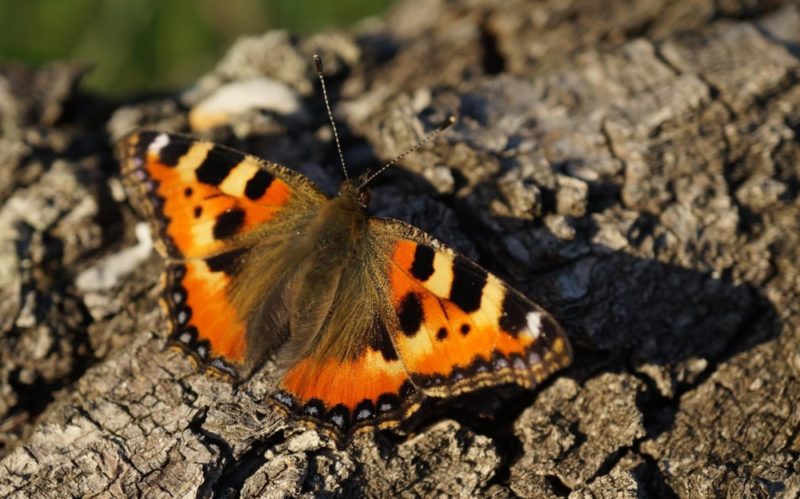A moth with a wingspan of 40 to 50 mm is not the largest among Lepidoptera. The urticaria butterfly delights observers, first of all, with its elegant shape and bright color. In addition to beauty, this representative of insects is famous for hard work: pollinates many different colors.
Material Content:
Description and features of butterfly hives
The beautiful moth is known under two equivalent scientific names: Aglais urticae and Nymphalis urticae. The species definition is one and the same, namely, it corresponds to the characteristic feature of the larva - nutrition and development on nettle shoots.
What does a butterfly urticaria look like:
- The medium-sized body is painted in dark colors, very pubescent.
- The outer part of the wings is serrated, one protrusion is larger.
- The predominant color of the wings is orange-brown.
- There are large black spots, between which lie yellowish patches.
- There is a white speck on the top of the upper wings.
- The gray-brown spots at the base of the hind wings are replaced by an orange-brown color with bright blue spots along the edge (a characteristic feature).
- The wings below are brownish-brown with a yellowish stripe.
Sexual dimorphism in urticaria is almost not manifested. The color and pattern of the wings of males and females differ little.
The size of this butterfly from the Nymphalidae family is smaller compared to lemongrass or brazhnik. However, urticaria is easy to see, as it flutters smoothly during the day, sits on flowers for a long time.
Habitat and habitat
Urticaria, along with cabbage whitewash and peacock eye, is one of the most common butterflies in Europe, Russia. They live in Kazakhstan, are found in Asia, spread further east to the Pacific coast of Russia, China, Japan, and China. Urticaria is a common sight for Siberia.
Butterflies of the species under discussion fly in the expanses of the steppes and semi-deserts, live on the edges of forests, roadsides, in floodplains, in meadows, in open woodlands, gardens and city parks. In the warm summer months, they are found in the mountains to an altitude of 3000 m and above.
What does a butterfly eat?
Moths visit flowers of primrose and other early spring plants, feed on floral nectar. Butterflies absorb food most actively in late summer. They should be stocked with lipids, which will gradually be used by a small body to maintain vital activity in the cold and hungry months.
Urticaria hibernate in adulthood, as they are resistant to low temperature.
Butterflies hide in autumn in the hollows of trees, deep cracks in the bark, the remains of plants. In the settlements of hives, the attics of houses and outbuildings are used as winter shelters.
When the air temperature in the street drops to 0 ° C, the butterfly's body goes into an inactive state. During diapause, metabolic processes slow down, the stored energy is spent economically. If at –21 ° C the butterfly freezes, then it thaws and is able to move.
Insect breeding
In mid-spring, butterflies emerge from their winter shelters and mate on nettles. A fertilized female lays eggs on the underside of the leaf. Development is completed within 1 to 3 weeks.
Urticaria larva is first green in color with black hairs. After 4 links, the color of the caterpillar turns black with longitudinal yellow stripes on the sides. The larvae feed on young leaves of the nettle and hop. Pupation occurs on a feed plant. After 2 weeks a butterfly emerges from the pupa, which hibernates.
Life span
Urticaria begin to fly in April, occur in feeding places until September. Within a year, 1 or 2 generations appear.
How long a butterfly hives lives depends on the conditions. In favorable years with sufficient feed, life expectancy is 9 months.
Interesting Facts
In summer and winter, butterflies become prey for birds and small rodents. The masking color of the “wrong” surface of the wings helps the hives to avoid the attack of enemies. However, half of the butterflies do not survive until spring due to the fact that they become prey for birds.
Often, hives wake up during snow melt in winter, when the February thaw begins, fly out of the shelter.
A butterfly that prematurely leaves hibernation can be kept at home, fed with a solution of sugar or honey (moisten cotton wool, place on a saucer).
The moth needs to be "invited" - moisten with syrup paws on which there are receptors. One feeding a day for 5 to 15 minutes is enough.
Urticaria are active during the day. At night and in inclement weather, they hide in the hollows of trees, caves, under the roofs of buildings in settlements. Observing the behavior of the butterfly will help predict the weather. If the day is clear, and the hives are looking for shelter, then in a few hours it will rain.
















